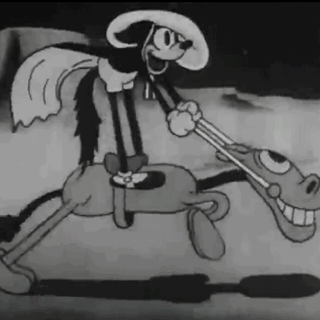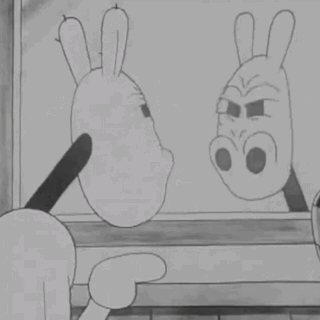Release date: August 1931
Series: Merrie Melodies
Director: Rudolf Ising
Starring: Johnny Murray (Foxy), The King's Men (Chorus), Ken Darby (Hippo)
Well, here we are! Our first ever Merrie Melody! This is the first cartoon to be directed by only one director (Rudolf Ising). Characters such as Porky, Bugs, and Elmer (as well as lesser known characters such as Sniffles and Egghead—the debate between whether he’s actually a prototype Elmer Fudd or a totally separate character wages on, similar to Happy Rabbit and Bugs) would all make their debuts in Merrie Melodies cartoons.
A little bit of history here. During the 1930-1931 season, Leon Schlesinger produced a series of live action musical shorts called “Spooney Melodies”, though only the first out of 5 actually was called Spooney Melodies—the remaining 4 shorts were titled “Song’nata”. After production ceased, it was replaced by Merrie Melodies, which would focus on animated musical shorts. To sum it up, all the previous anthropomorphized animals and objects coming to life shorts singing and dancing would now be under Merrie Melodies, whereas more plot based cartoons would be under the Looney Tunes names.
The Merrie Melodies cartoons were, as explained above, musical cartoons. The cartoons served as a way to plug soundtracks from movies made at warner bros, advertising sheet music and recordings.
Beginning in 1934, all of the Merrie Melodies cartoons would be made in color (using the cheaper two-strip Cinecolor process as opposed to Disney’s richer three-strip Technicolor process, which they had the rights to), whereas the Looney Tunes cartoons would be in black and white. Merrie Melodies soon began to phase out their emphasis on musical advertising, and the only distinguisher between MM and LT was the color difference. Starting in 1942, Looney Tunes would eventually go into color, and by 1943-1944 there was practically no distinguishable difference between the two except for the opening title songs (Looney Tunes would use “The Merry-go-Round Broke Down”, whereas Merrie Melodies would use “Merrily We Roll Along”).
On a more technical note, Johnny Murray begins to appear in more concentration as a voice artist. He would supplement voices for the likes of Foxy, Goopy Geer, and Bosko.
Interesting, isn’t it? Anyway, here we have Lady, Play Your Mandolin! by Rudolf Ising. Some notable firsts: first Merrie Melodies cartoon, first appearance of Foxy (and thusly the first appearance of a new character made specifically for Looney Tunes—Bosko was brought into Looney Tunes from the outside), and first cartoon to have Bob Clampett on the team as an assistant animator. He, Friz Freleng, and Bob McKimson (who was an in-betweener) would all be animating at the time and all grow to be notable directors.
The short opens in a Mexican café with a bunch of drunks singing a rousing chorus of “Lady, Play Your Mandolin”. What a way to abide by the rules of prohibition! This scene is very peppy and immediately puts you in a good mood. It almost feels more uplifting than the same premise/scenes with Bosko, but that’s probably because those scenes are overshadowed (for me, anyway) with the uncomfortableness of Bosko’s existence as a black caricature. Nevertheless, highlights including a gorilla stuffing a duck’s gullet with beer, a bird playing a horn and dancing along the keys of a piano, and an enormous hippo bellowing an ear-splitting scream in celebration.
Pan to our hero, Foxy. Foxy would have a pretty limited career, only starring in 3 shorts (and getting KILLED OFF in One More Time after Walt Disney expressed concern to Ising about the resemblance to everyone’s favorite mouse). This entire cartoon is quite similar to Disney’s The Gallopin’ Gaucho from 1928. Enough history, though. Here, Foxy is happily galloping along with his horse when he approaches the café.
Equally as thrilled as Foxy, the horse makes a run towards the café. Foxy grabs him by the tail, and cruelly (albeit funnily and cleverly) ties his neck around a cactus to keep him tied up while foxy heads in to liquor himself up.
Foxy bursts into the saloon and is greeted by thunderous applause and cheers. Seems he’s a regular. He launches into “A Gay Caballero” as he swaggers away in this great walk cycle above. The animation is so smooth! This is the most personality we’ve seen in a cartoon yet!
An anthropomorphic coat rack comes up and physically takes Foxy’s cape and hat while he orders himself a beer. Foxy flips the coin before giving it to the gorilla we saw at the beginning. The gorilla pushes his nose down and out come his teeth like a cash register as he stashed away his shiny new coin—a very fun and imaginative little gag!
A duck saunters to the front of the stage in the saloon, and, taking off its sombrero, uses it as a horn to signal the start of the show—the same gag reused from Ups ‘n Downs where his body inflated as he takes a deep breath and gets paper thin as he blows.
We’re greeted with an unnamed female counterpart to Foxy. She appears in an Animaniacs episode under the name Roxy, so to make things easier I’ll just call her that. This post is already a mile long! Roxy and Foxy sing “Lady, Play Your Mandolin” together in a duet. The melody itself is really catchy and upbeat! Foxy’s singing isn’t too bad, but Roxy is a bit obnoxious, but leaning on the endearingly obnoxious side.
We’re reminded of the horse, who frees himself from his restraint with a pull of the tail accompanied by some beautifully smooth animation. The horse chimes in with the festivities (mimicking the sound of a muted trumpet? Trombone? Some sort of horn). Foxy, clearly agitated, smashes a beer bottle against the horse’s head, who gets snookered by the impact alone.
A lot happens next that you sorta need to see yourself to really comprehend. The horse saunters into the bar chugging more liquor as the scene ravages on. Foxy and Roxy are still singing (Foxy a clear imitation of Al Jolson), a dog’s beard takes a life of its own and starts dancing while his teeth pop out of his mouth and chatter to the rhythm while a mouse pops out of his sombrero, various shots of Foxy and Roxy... the pacing is very frenetic and fast. GOOD! It’s a nice change. This cartoon itself is paced relatively quickly—not many of the previous cartoons can boast the same.
The horse stumbles up to a counter and sees itself in the mirror, when all of the sudden it starts having these wonderfully terrifying hallucinations. The horse lets out a scream and runs down the aisle through the bar, drunkenly dancing and giving a delightfully freakish grin towards the audience.
The cartoon ends with the horse spontaneously combusting and a final verse of “Lady, Play Your Mandolin!”. Foxy closes the cartoon with a “So long, folks”, the tagline that would be used for Merrie Melodies (whereas Looney Tunes would utilize “That’s all, folks!”). The Merrie Melodies sign-offs would change depending on who starred in the cartoon. It wasn’t until 1936 that both series would adopt “That’s all, folks!” written out in script. Porky would use the drum ending from 1937-1946, where the script ending was revitalized against the colored rings instead of a plain black background.
What a cartoon! This is certainly one of my favorites. The cartoon is still relatively plotless, but Foxy seems to have some more personality than Bosko (like that great gif of him swaggering down the aisle). The voice acting is still pretty painful, but the background score is catchy and makes it a bit more bearable. This is a very high energy cartoon with a lot of absurd visuals, it’s hard to pin them down! The horse spontaneously combusting is great. I could definitely see how this cartoon would be scary, but I find it more fascinating than frightening. Overall, it pales in comparison to the shorts that’d be churned out by the end of the decade and onwards through the 40s and 50s, but it’s a nice, cheery change of pace from the Bosko cartoons that tend to drag on and on. I’d recommend a watch!














No comments:
Post a Comment